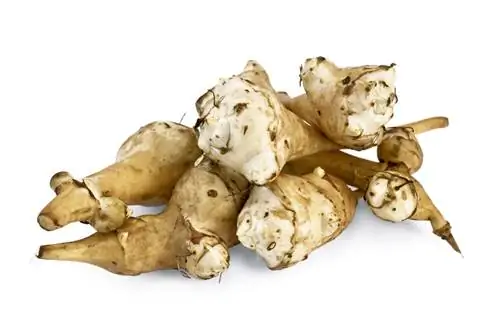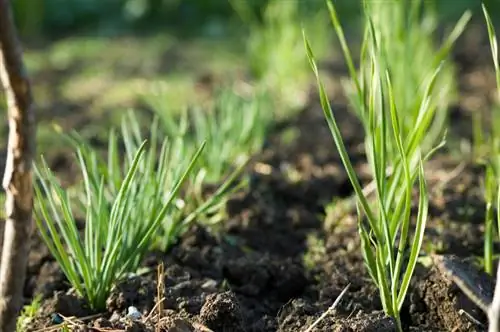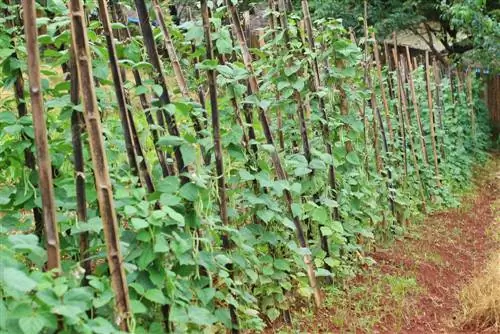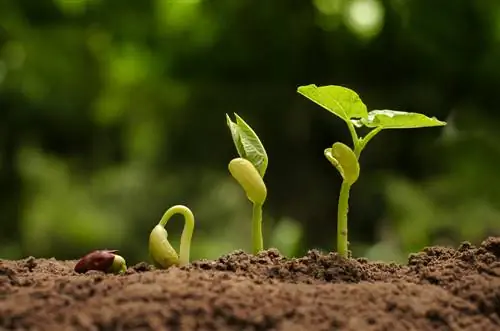- Author admin [email protected].
- Public 2023-12-16 16:46.
- Last modified 2025-01-23 11:19.
Jerusalem artichoke is a versatile vegetable that enriches the diet raw and cooked. Growing it in the garden is incredibly easy because the plant is hardy and has hardly any requirements in terms of location and care.
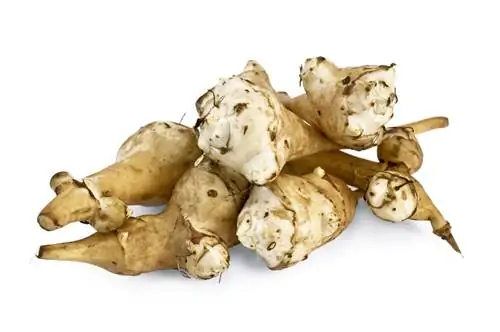
How should you plant Jerusalem artichokes correctly?
Jerusalem artichoke plants thrive best in sunny or partially shaded locations and prefer well-loosened, nutrient-rich soil. The tubers are planted up to 15 cm deep, with a distance of at least 40 cm between plants. The planting time is ideally in spring.
How to plant Jerusalem artichoke?
Jerusalem artichoke is planted outdoors as a seedling or tuber. The tubers are dug up and planted in the desired location. Alternatively, a tuber remains in the ground and sprouts again.
Where does Jerusalem artichoke grow best?
Topinambur does not place any great demands on the location. It grows in sunny and partially shaded places. If abundant flowering is desired, the plant needs a lot of sun.
Are there particularly suitable locations?
Jerusalem artichoke is an ideal privacy screen that looks very pretty with its yellow flowers. That's why the plant is often grown on fences. Planting around the compost heap is also ideal because the tubers find enough nutrients here.
What should the soil be like?
Topinambur thrives best in well-loosened, nutrient-rich soil. The plant cannot tolerate waterlogging.
What does good soil preparation look like?
- Loose the soil deeply
- Removing weeds
- Pick up stones
- Enrich nutrient-poor soils with compost
- Loosen compacted soils with sand
- If necessary, create a root barrier
Does Jerusalem artichoke have to be preferred?
If the Jerusalem artichoke is propagated via seeds, it should be sown in the sowing bed from March onwards. From a height of ten centimeters, the plants are planted outdoors.
How to plant Jerusalem artichoke?
The tubers are placed up to 15 centimeters deep in the soil. The deeper they are, the more yield they produce.
What planting distance should be maintained?
Jerusalem artichoke grows very quickly and densely. Therefore, maintain a larger planting distance. There should be at least 40 centimeters between plants. The same applies to the tubers, which are laid out 40 by 40 centimeters apart.
When is the best time to plant?
The beginning of spring is the best time to plant. Then the plants have enough time to develop plump tubers. In principle, the tubers can be laid out all year round.
What care does Jerusalem artichoke need?
The plant is extremely easy to care for. Weeds should be removed regularly in spring. This is no longer necessary later, as Jerusalem artichokes increase in size and prevent weeds from emerging.
Is fertilization necessary?
If the soil is nutrient-rich, fertilizer is unnecessary. If the soil is poor in nutrients, it is enough to rake in some mature compost. Caution is advised with nitrogen-rich fertilizer. Too much nitrogen causes the tubers to rot.
How often is Jerusalem artichoke watered?
Especially in midsummer, Jerusalem artichoke needs a lot of water so that the tubers stay plump. Watering several times a day is advisable. Waterlogging must be avoided at all costs.
How is Jerusalem artichoke propagated?
Since the seeds do not ripen on the flowers in our latitudes, seeds (€6.00 on Amazon) must be purchased from specialist retailers. It is easier to propagate via the tubers, which remain in the ground or are planted somewhere else.
When is Jerusalem artichoke harvested?
The best harvest time is autumn. Early varieties are ready to harvest from August, late varieties in late autumn. Jerusalem artichoke can generally be harvested all year round as long as the ground is frost-free. Harvesting should only be avoided if there is severe drought in midsummer.
How to prevent excessive spreading?
When growing on fences in the garden, a root barrier is strongly recommended. Otherwise, trouble with the neighbors is inevitable. Regular harvesting and tuber removal is also helpful.
Is Jerusalem artichoke suitable for keeping in a pot?
Jerusalem artichoke can be grown well in a taller container. This prevents the plants from spreading too much.
Does Jerusalem artichoke need to be cut?
In winter, the upper parts of the plant withdraw completely. Cutting is therefore only necessary in very small gardens if the plant has spread too much.
Which plants does Jerusalem artichoke get along with?
Jerusalem artichoke is a heavy feeder that should generally not be kept with other heavy feeders. Low-eating foods such as beans, on the other hand, go well. However, it should be borne in mind that Jerusalem artichoke produces a lot of foliage and does not allow other plants enough light.
What diseases threaten Jerusalem artichoke?
Mildew occasionally spreads on the upper parts of the plant. The tubers are hardly damaged as a result. If necessary, the affected parts are cut off and discarded.
What pests should you watch out for?
Voles and moles love the tubers just as much as people do. The rodents should be driven away using appropriate measures. Attention: Moles are protected! Snails like to attack the foliage. Regular collection can be helpful. However, snail damage hardly harms the tubers.
Tips & Tricks
Jerusalem artichoke contains the multiple sugar inulin (not to be confused with insulin), which is also well tolerated as a sweetener in diabetes. Growing root vegetables is therefore particularly recommended when feeding diabetics.

